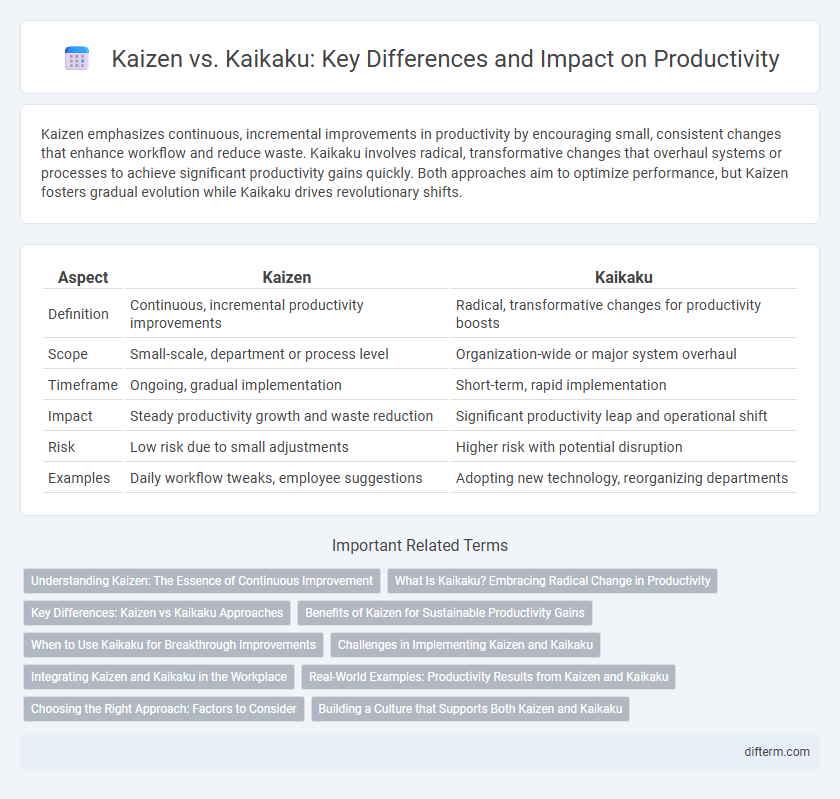Kaizen emphasizes continuous, incremental improvements in productivity by encouraging small, consistent changes that enhance workflow and reduce waste. Kaikaku involves radical, transformative changes that overhaul systems or processes to achieve significant productivity gains quickly. Both approaches aim to optimize performance, but Kaizen fosters gradual evolution while Kaikaku drives revolutionary shifts.
Table of Comparison
| Aspect | Kaizen | Kaikaku |
|---|---|---|
| Definition | Continuous, incremental productivity improvements | Radical, transformative changes for productivity boosts |
| Scope | Small-scale, department or process level | Organization-wide or major system overhaul |
| Timeframe | Ongoing, gradual implementation | Short-term, rapid implementation |
| Impact | Steady productivity growth and waste reduction | Significant productivity leap and operational shift |
| Risk | Low risk due to small adjustments | Higher risk with potential disruption |
| Examples | Daily workflow tweaks, employee suggestions | Adopting new technology, reorganizing departments |
Understanding Kaizen: The Essence of Continuous Improvement
Kaizen embodies continuous improvement through small, incremental changes that enhance productivity by fostering employee involvement and eliminating inefficiencies. This approach emphasizes sustaining long-term growth by focusing on gradual process enhancements rather than abrupt transformations. Understanding Kaizen's core principles helps organizations build a culture of steady progress and operational excellence.
What Is Kaikaku? Embracing Radical Change in Productivity
Kaikaku represents a radical transformation approach in productivity by implementing fundamental changes to existing processes rather than incremental improvements. This methodology aims to achieve significant breakthroughs in efficiency, often through disruptive innovations or restructuring. By embracing Kaikaku, organizations can rapidly adapt to market demands and technological advancements, driving substantial competitive advantages.
Key Differences: Kaizen vs Kaikaku Approaches
Kaizen emphasizes continuous, incremental improvements driven by all employees to enhance productivity gradually, while Kaikaku involves radical, large-scale changes initiated by management for immediate, significant transformations. Kaizen fosters a culture of ongoing refinement, focusing on small adjustments in processes, whereas Kaikaku targets breakthrough innovation or restructuring efforts that rapidly optimize workflows. Understanding these key differences helps organizations implement the most effective approach based on their productivity goals and operational needs.
Benefits of Kaizen for Sustainable Productivity Gains
Kaizen drives sustainable productivity gains by fostering continuous, incremental improvements that engage all employees in problem-solving and process optimization. This approach reduces waste, enhances quality, and boosts efficiency without the disruptions often associated with radical changes like Kaikaku. Over time, Kaizen builds a culture of ongoing innovation and operational excellence, ensuring long-term competitive advantage.
When to Use Kaikaku for Breakthrough Improvements
Kaikaku is ideal for breakthrough improvements requiring radical changes in processes or organizational structure, especially when incremental Kaizen methods fail to address deep-rooted inefficiencies. It is most effective during periods of business transformation, rapid market shifts, or technological advancements that demand significant innovation. Applying Kaikaku strategically accelerates productivity gains by fundamentally redesigning workflows and systems.
Challenges in Implementing Kaizen and Kaikaku
Implementing Kaizen faces challenges such as employee resistance to continuous small changes, difficulty maintaining long-term engagement, and limited impact on systemic issues. Kaikaku, involving radical transformation, struggles with higher risks, significant resource demands, and potential disruption to existing workflows. Both approaches require strong leadership commitment and effective change management to overcome these barriers and achieve sustainable productivity improvements.
Integrating Kaizen and Kaikaku in the Workplace
Integrating Kaizen and Kaikaku in the workplace enhances productivity by balancing continuous incremental improvements with strategic, radical changes. Kaizen emphasizes daily, small-scale enhancements driven by employee involvement, while Kaikaku focuses on transformative shifts to processes or systems for breakthrough performance. Combining these methodologies fosters a dynamic environment where gradual refinements support long-term innovation and operational excellence.
Real-World Examples: Productivity Results from Kaizen and Kaikaku
Kaizen drives incremental productivity improvements through continuous small changes, exemplified by Toyota's assembly line enhancements that boosted output by 25% over five years. Kaikaku involves radical, transformative changes, such as Fujifilm's shift from photographic film to digital imaging, resulting in a complete business model overhaul and sustained competitive advantage. Real-world data confirms Kaizen's role in steady, long-term efficiency gains, while Kaikaku delivers breakthrough productivity leaps crucial for industry disruption.
Choosing the Right Approach: Factors to Consider
Selecting between Kaizen and Kaikaku depends on the scope of change desired within productivity management. Kaizen emphasizes continuous, incremental improvements driven by employee engagement, ideal for stabilizing existing processes and fostering a culture of ongoing development. Kaikaku targets radical, transformative changes often necessary for overhaul initiatives, requiring strategic planning and significant resource allocation to achieve rapid productivity leaps.
Building a Culture that Supports Both Kaizen and Kaikaku
Building a culture that supports both Kaizen and Kaikaku drives continuous improvement and radical innovation within organizations. Emphasizing employee engagement, open communication, and leadership commitment fosters an environment where incremental changes and transformative breakthroughs coexist effectively. Integrating structured Kaizen activities with strategic Kaikaku initiatives enhances productivity, operational agility, and sustainable competitive advantage.
Kaizen vs Kaikaku Infographic

 difterm.com
difterm.com